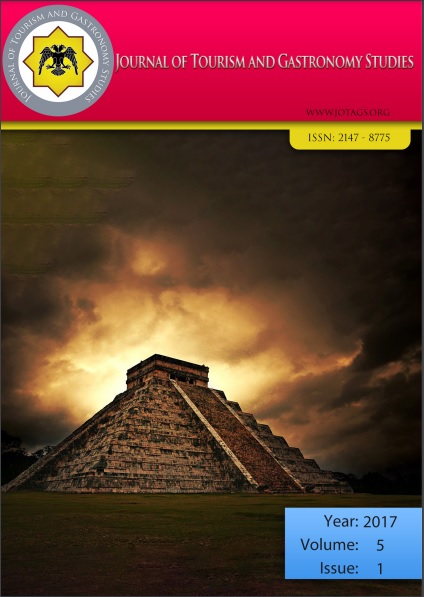Competitiveness in Food and Beverage Companies: An Architectural Perspective
Keywords:
Tourism, Architectural design, Food and beverage industries, CompetitionAbstract
In this study, competitiveness in food and beverage industries is evaluated with an architectural perspective and using design as a differentiation tool for sustainable competitive is discussed. In the introduction, eating and drinking activities, food and beverage companies are focused and in the strategy and competitiveness section, food and beverage business is discussed. In the architectural design section design is evaluated as an optimization problem and in the conclusion competitiveness over the architectural design is discussed.
References
Bayraktar, Ö. (2006). İstanbul Beyoğlu Bölgesi’nde Bazı Konut Dışı Yeme İçme Mekanlarının Oturma Elemanlarının İrdelenmesi, Mimar Sinan Üniversitesi, Fen Bilimleri Enstitüsü, Yüksek Lisans Tezi.
Bee-Lia Chua, Naehyun (Paul) Jin, Sangmook Lee ve Ben Goh (2014) Influence of Mechanic, Functional, and Humanic Clues on Customers’ Experiential Values and Behavioral Intentions in Full-Service Restaurants, Journal of Foodservice Business Research, 17, 67-84.
Bekar A. ve Sürücü Ç. (2015) Yiyecek İçecek İşletmesi Tasarımının Tüketici Tercihleri Üzerindeki Etkisi, Türkiye Sosyal Araştırmalar Dergisi 19 (1), 349-376
Erbil, Y. ve Akıncıtürk, N. (2010).Mimarlık Ofislerinin Yenilikçilik Sürecinde; Kullanıcı ve Müşterilerin Stratejik Rolü Üzerine Kalitatif Bir Araştırma Deneyimi, Megaron, 5(1), 43- 50.
Gero, J. (1990) Design Prototypes: A Knowledge Representation Schema for Design, AI Magazine, 11(4), 26- 36.
Giaccardi, E, ve Fıscher, G. (2008). Creativity and Evolution: A Metadesign Perspective, Digital Creativity, 19(1) 19- 32.
Kim,W.G. Lee, Y.K. Yoo, Y.J. (2006). Predictors of Relationship Quality and Relationship Outcomes in Luxury Restaurants. Journal of Hospitality & Tourism Research, 30(2), 143–169.
Kyoung-Bae K. Shin-Young K. ve Sang-Hyeon P. (2014) Perceiving the Atmosphere of Asian Restaurants: European Customers vs. Asian Customer, International Journal of Tourism Sciences, 14 (2), 111-125.
Lindahl, G. ve Ryd, N. (2007). Clients’ Goals and the Construction Project Management Process Facilities, Construction Project Management, 25(3/4), 147- 156.
Liu, Y. ve Jang, S. (2009). Perceptions of Chinese Restaurants in the U.S.:What Effects Customer Satisfaction and Behavioral Intentions, International Journal of Hospitality Management, 28, 338–348.
Mathisen, G.E., Einarsen, S., Mykletun, R. (2008). The Occurrences and Correlates of Bullying and Harassment in the Restaurant Sector. Scandinavian Journal of Psychology, 49, 59–68
Piotrowski, C.M ve Rogers, E.A. (2007). Designing Commercial Interiors, 2.baskı, John Wiley and Sons, New Jersey:Canada.
Uysal, G. (2010). Stratejik Yönetim Ders Notları, On dokuz Mayıs Üniversitesi, İİBF, İsletme Bölümü, Samsun.
Wall, E.A. ve Berry, L.L. (2007). The Combined Effects of the Physical Environment and Employee Behavior on Customer Perception of Restaurant Service Quality, Cornell Hotel and Restaurant Administration, 48 (1), 59– 69.
L1: http://tr.wikipedia.org/wiki/Kaos_teorisi[03.01.2017]
L2:http://www.ataaof.edu.tr/dosyalar/ornek.pdf [30.11.2013]
L3: http://tr.wikipedia.org/wiki/Marjinal_fayda[03.01.2017]
Downloads
Published
How to Cite
Issue
Section
License
Copyright (c) 2022 Journal of Tourism & Gastronomy Studies

This work is licensed under a Creative Commons Attribution-NonCommercial 4.0 International License.








